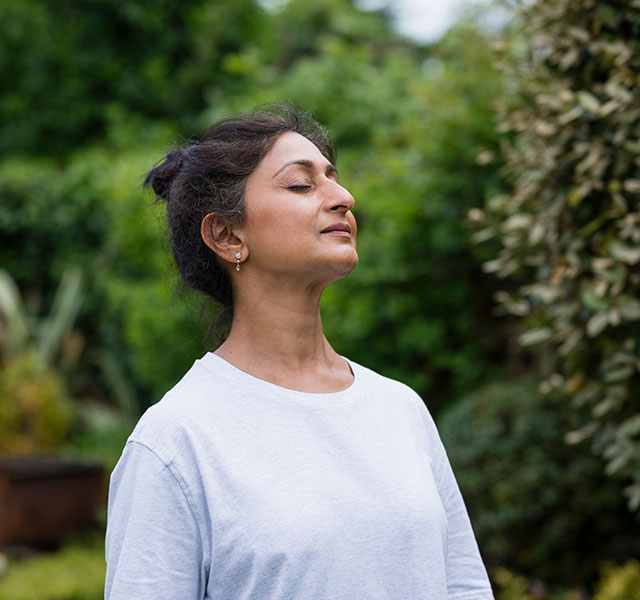Breath is the essence of life. We cannot survive without it. Yet, most of us are not breathing in a way that supports our health and well-being.
“How you breathe can make a big difference in how you feel, and it can have downstream consequences that affect other systems and tissues,” says Mathew Kulas, MA, LAc, an acupuncturist at Henry Ford Health. “How quickly and how deeply you breathe has a significant effect on the parasympathetic nervous system, which controls the body’s relaxation response.”
How You Breathe Matters
Most of us breathe in and out all day long without pausing to think about it. But it turns out that paying attention to your breath can produce big changes in both mind and body.
“When the rate of breathing is slow, our parasympathetic nervous system gets the message that everything is okay, that it’s safe to relax,” Kulas says. “Fast, shallow breathing, on the other hand, sends signals to the sympathetic nervous system that we’re in danger, and our fight, flight or freeze response kicks in.”
With time and practice, we can learn how to breathe more slowly and deliberately, which can help restore our body’s natural balance and promote wellness. In fact, studies show that lung capacity, which is developed through slow, deep breathing, is the single greatest predictor of longevity, above diet, exercise and other lifestyle factors.
Breathe Like A Baby
If you’ve ever watched a baby breathing, you’ve seen their belly rise and fall with their breath. There are plenty of reasons why newborn babies and young children default to breathing in and out through the nose, starting with survival.
Newborn babies’ throats are designed to allow them to breathe and suck at the same time, without choking. Our noses also process inhaled air differently than our mouths, and in ways that help keep us safe and healthy.
Unfortunately, some of us begin unconsciously breathing through our mouths as we grow older, and that can lead to a host of health issues ranging from bad breath and dry mouth to asthma and sleep apnea.
The Benefits Of Nose Breathing
Breathing through your nose acts as a sort of natural medical device filtering toxins, humidifying nasal passages and enhancing circulation. The only time mouth breathing is necessary is during intense exercise or when your nasal passages are blocked (from congestion, cold or allergies).
Here’s a closer look at some of the perks of nose breathing:
- It filters toxins: The hairs inside your nose (cilia), act as a natural filtration system, preventing allergens, dust and pollen from entering the lungs. With mouth breathing, everything you inhale goes straight to your lungs.
- It humidifies the air: Your nasal passages moisturize and warm the air you inhale. When the air that comes in is closer to body temperature, it’s easier for your lungs to use.
- It produces nitric oxide: Breathing through your nose, also called nasal breathing, releases nitric oxide (NO). That nitric oxide helps widen your blood vessels and makes it easier for nutrient-rich oxygenated blood to reach all of your body’s organs and tissues.
Breathing through your nose can also promote slower, deeper breathing. “This style of breathing recruits the vagus nerve, which regulates our fight or flight response and coaxes our bodies into a rest and digest state,” Kulas says. Practices such as qigong, acupuncture, Tai Chi and yoga achieve similar results.
Easy Breathing Strategies
Learning to breathe through your nose with targeted exercises can help increase your lung capacity, enhance respiratory function and relieve stress and anxiety.
If you find yourself mouth breathing more than you should, don’t worry. “Breathing is a foundational practice,” Kulas says. “There’s always room for improvement.” To that end, here are a few simple exercises that you can do on your own at home:
- Alternate nostril breathing: Just as the name implies, with alternate nostril breathing you hold one nostril closed with your finger while breathing through the other. Since you’re focused on your breathing, alternate nostril breathing can also be a meditative experience.
- Belly breathing: Also called diaphragmatic breathing or abdominal breathing, belly breathing involves taking slow, deep breaths through your nose. Inhale through your nose and feel your belly rise and fill with air. Then exhale slowly through pursed lips.
- Counting: Many religious and yogic traditions cite four to six breaths per minute as the ideal rhythm for health and wellness. “Some people breathe in for seven seconds, pause and breathe out for another seven seconds,” Kulas says. “Others do variations where they inhale for four seconds, pause for six seconds and then exhale for eight.” No matter which rhythm you choose, focus on your belly moving out in front of you on the inhale, as if someone is pulling your belly button with a string.
Breathing is one of those things we can all improve—and it doesn’t have to be time-consuming or difficult. “Just two to five minutes of slow, deep breathing signals the body to move out of a fight, flight or freeze state,” says Kulas. “Giving your nervous system that break once or twice each day can make a huge difference.”
To find a doctor at Henry Ford, visit henryford.com or call 1-800-436-7936.
Mathew Kulas is a licensed acupuncturist and sees patients at Henry Ford Medical Centers located in Northville and Royal Oak.



